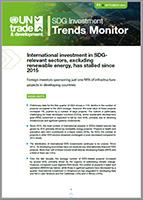
SDG Investment Trends Monitor (Issue 5)
Foreign investors sponsoring just one fifth of infrastructure projects in developing countries
- Preliminary data for the first quarter of 2024 shows a 11% decline in the number of projects compared to the 2023 average. However, the total value of these projects increased 7%, pushed by a number of large projects.
The outlook is particularly challenging for least developed countries (LDCs), where sustainable development goal (SDG) investment is expected to fall by over 25%, primarily due to declining infrastructure and agrifood systems investments.
- Since 2015, the total number of international projects in SDGs-related sectors has grown by 25% primarily driven by renewable energy projects. Projects in health and education also have contributed to a lesser extent (22%).
By 2023, the number of projects in other SDG sectors remained unchanged or even decreased compared to 2015 levels.
- The distribution of international SDG investments continues to be uneven. Since 2015, 18 developing economies have not received any internationally financed SDG projects. More than half of these include small islands developing States (SIDS) and a third of them are LDCs.
- Over the last decade, the average number of SDG-related projects increased by around 20%, primarily driven by the urgency of addressing climate change. However, compared to pre-Agenda 2030 levels, the number of projects in water and sanitation (WASH) has halved, while those in agrifood systems have decreased by a quarter.
International investment in infrastructure has stagnated in developing Asia and fell in Latin America and the Caribbean (-9%) and in Africa (-24%).
- Foreign private investors are among the sponsors of about a fifth of the project finance deals in infrastructure and renewable energy sectors and of about a seventh of social infrastructure (projects in health, education and WASH) projects.
However, there are still significant opportunities to expand their involvement. Increasing foreign investment in these sectors could accelerate progress toward sustainable development, particularly in economies where investment gaps persist.
- Multilateral development banks (MDBs) can play a crucial role in attracting foreign private investment for infrastructure projects in developing economies. In developing economies, MDBs participate in about 5% of all project finance deals aligned with the SDGs.
While most of their interventions (over 75%) are in middle income countries, in relative terms MDBs contribute to a larger share of project financing in LDCs, where they are involved in nearly a quarter of international human capital projects and around one-fifth of infrastructure and renewable energy initiatives.
- A substantial share of domestic SDG projects in developing countries is linked to China's Belt and Road Initiative (BRI), launched in 2014.
The BRI has become a key driver of SDG investments, not only in Asian countries but also in Africa and Latin America and the Caribbean. In Africa, for instance, BRI projects account for a third of all investments in social infrastructure sectors like healthcare, education, and water and sanitation.
International investment in SDG-relevant sectors, excluding renewable energy, has stalled since 2015 - SDG Investment Trends Monitor (Issue 5) (UNCTAD/DIAE/MISC/2024/5)
20 Sep 2024


